Catholic Customs
 |
 |
 |
 |
 |
 |
 |
The Return of Light for Candlemas
At the beginning of February nature is characterized by a conflict between the dark nights of winter and the bright days of Spring. Since Christmas, the daylight has been shining for longer hours that increase every day. By Candlemas (February 2) the coming victory of the light over the darkness and the promise of Spring is manifest.
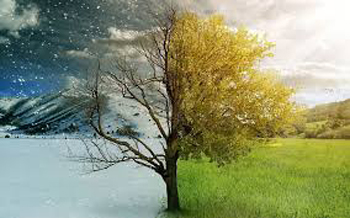 People of the past were carefully attentive to the changes in the natural world, and they placed great significance on the signs that nature gave during times of transition from one season to another. With the introduction of Christianity, the old pagan rituals and symbols gave way to Catholic customs that came from a true understanding of God's plan in creating the natural world.
People of the past were carefully attentive to the changes in the natural world, and they placed great significance on the signs that nature gave during times of transition from one season to another. With the introduction of Christianity, the old pagan rituals and symbols gave way to Catholic customs that came from a true understanding of God's plan in creating the natural world.
Catholics understood that the victory of the daylight over the darkness at Candlemas was symbolic of Our Lord's victory over the Devil's reign. On Candlemas, the Church honors Our Lord through the words of holy Simeon as the "light to the revelation of the Gentiles."
Simeon's prophetic canticle of Our Lord's coming victory was reflected in nature's cycle. Just as the darkness of winter was losing its power over the world, so too was paganism and immorality approaching its demise with every day that the Christ Child grew older.
The sun's triumph reflected in people's customs
Austrian children attentively watched the sky on Candlemas Day to see if they could catch a glimpse of the sun breaking through the clouds of the dark winter sky to shed its rays upon the earth. When a ray was seen, the children sang a lovely song greeting the light:
 Hail, glorious herald, holy light,
Hail, glorious herald, holy light,
God sends you from His Heaven bright.
Your cheerful glow and golden rays
May bring us happy summer days.
Lead us through earthly toil and strife
To everlasting light and life. (1)
On Candlemas evening, the children in some Russian villages sat near the outskirts of the town listening to legends told by the elders of the town. At dusk, they expectantly waited to see if the sun would peep from behind the mountain before sunset, which would denote the quick arrival of Spring. They sang a traditional song that began, "O you bright sun, come, peek out from behind the hills!" (2)
In the Middle Ages, Candlemas was a "Quarter day" when servants and maids were paid for the year, accounts were settled, and tenants paid their rent. The landowners often invited their tenants along with their families to a grand banquet after the rent was paid. In Austria, the farm servants were given a feast prepared by the farmer's wife herself. (3)
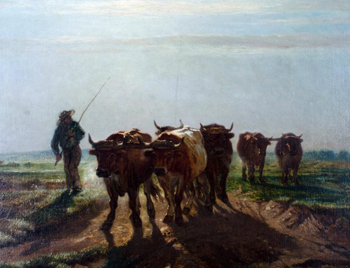 This day was also a traditional day to remove the cattle from the hay meadows and from the fields that were to be ploughed and sown in the Spring. Farmers began working outside again and preparing the fields for the first planting. Women set their spinning and knitting aside to attend to the outdoor chores.
This day was also a traditional day to remove the cattle from the hay meadows and from the fields that were to be ploughed and sown in the Spring. Farmers began working outside again and preparing the fields for the first planting. Women set their spinning and knitting aside to attend to the outdoor chores.
Shoemakers and other artisans who worked indoors put away their candles on this day as the return of the light removed the need for candlelight until the darker days of Autumn. (4) Candlemas not only changed people's work customs, but also was the marker to determine the future weather. After Candlemas, a man could expect to either have another strong blast of Winter's frost and snow or sweet signs of the coming Spring.
In England, the people believed that the badger woke up from hibernation on this day and the weather determined whether he went back into his hole or remained above ground. If the badger saw his shadow due to sunny weather, he went back to sleep expecting a long winter.
The Germans used the same method to discover the upcoming weather, except that they replaced the badger with a hedgehog or, in some places, a bear.
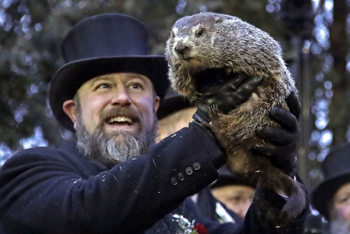 German and English immigrants brought their Candlemas folklore to America. Since the groundhog was common in Pennsylvania and other areas where the Germans immigrated, they associated their lore about the hedgehog, badger, or bear with the groundhog. Hence, Midwestern farmers called this day "Ground-Hog Day."
German and English immigrants brought their Candlemas folklore to America. Since the groundhog was common in Pennsylvania and other areas where the Germans immigrated, they associated their lore about the hedgehog, badger, or bear with the groundhog. Hence, Midwestern farmers called this day "Ground-Hog Day."
The town of Punxsultawney, Pennsylvania even made an official town groundhog named "Punxsutawney Phil." For over 120 years, starting in 1887, people have been following the predictions of this groundhog. Even today, this groundhog is watched carefully as he leaves his den to see what his reaction will be and a festival is held in the town. (5)
Symbolic foods & flowers of Candlemas
Catholics of the past not only observed the animals during this time of the year, but also the plants, many of which have deep symbolic meanings.
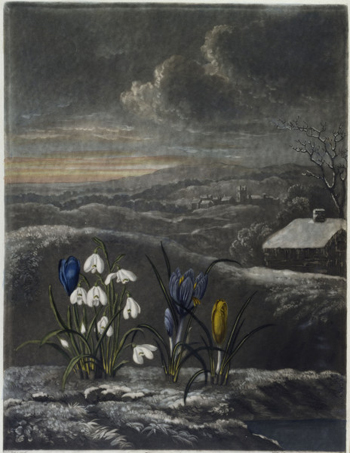 In the Middle Ages, the Snowdrop was known as the Candlemas Bells or the Purification Flower. The innocent medieval man believed that the Snowdrop, as an emblem of purity and virginity, blossomed on the day that Our Lady presented Our Lord in the Temple and that this flower has blossomed ever since on every Candlemas to honor Our Lady. (6)
In the Middle Ages, the Snowdrop was known as the Candlemas Bells or the Purification Flower. The innocent medieval man believed that the Snowdrop, as an emblem of purity and virginity, blossomed on the day that Our Lady presented Our Lord in the Temple and that this flower has blossomed ever since on every Candlemas to honor Our Lady. (6)
To honor this pious legend, people did not bring Snowdrops into their house before Candlemas. On that day, bunches of Snowdrops were collected and brought inside to purify the house. In Italy and other places in Europe, the image of Our Lady on the church altar was removed and replaced with Snowdrops which were strewn over it to symbolize the purity that Our Lady radiates wherever she goes. (7)
In addition to contemplating the symbolism in nature, Catholic peoples also prepared food that reflected the joy of the day.
In France, Belgium and Swiss Romany the people eat many special carnival treats on this day such as galettes, crêpes, beignets and cidre. Some people attribute the origin of this custom to Pope Gelasius I who provided for the pilgrims arriving in Rome by having pancakes prepared for them. (8)
Crêpes are also symbolic of the sun, making them a fitting dish to commemorate the return of sunny days at Candlemas. (9)
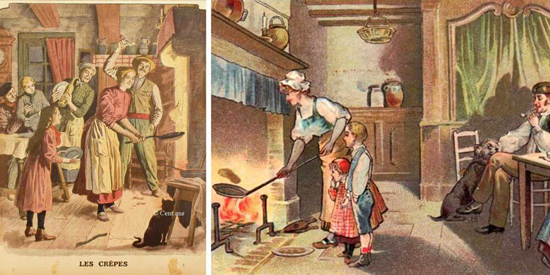 Farewell to Christmas
Farewell to Christmas
The change in the natural world reflects well the transition that Candlemas marks in the liturgical year. In the liturgical calendar, Candlemas is the last day of the Christmas season. In the past, many Catholics cherished every moment of the Christmas season, keeping up the joy and merriment of Christmas until the 40 days had come to an end.
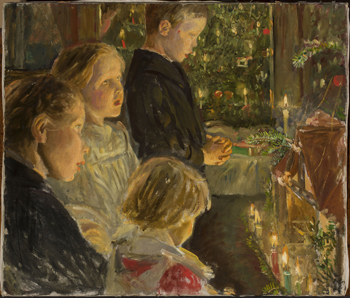 Candlemas Day was the last day to sing traditional Christmas carols and also the day that Christmas decorations had to be removed. Although the traditional day to remove Christmas decorations and greenery was the Epiphany, some Catholic peoples of Europe, especially in Poland, Germany, Austria and England, kept their decorations up until February 2 because of their deep love for Christmas.
Candlemas Day was the last day to sing traditional Christmas carols and also the day that Christmas decorations had to be removed. Although the traditional day to remove Christmas decorations and greenery was the Epiphany, some Catholic peoples of Europe, especially in Poland, Germany, Austria and England, kept their decorations up until February 2 because of their deep love for Christmas.
In most countries, even if other decorations were removed on the Epiphany, the crèche or Christ Child remained in a prominent place until Candlemas. In many French homes, the crèche was reverently put away on the afternoon or evening of Candlemas.
Christmas plants and greenery and the Yule log were also burned on Candlemas (if this was not already done on the Epiphany) as a last farewell to Christmas. The ashes were spread on fields and gardens to bring a successful harvest and protection against blight.
Some English farmers fed the Christmas greens to their cattle to protect them from disease. People saved sprigs of holly from the church or sprigs collected on Christmas Eve as efficacious means to protect themselves against demons and witches. (10)
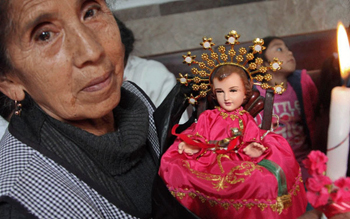
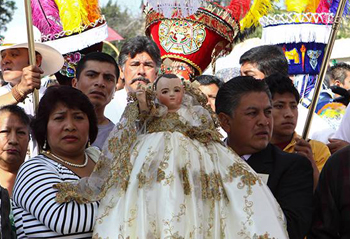 The task of removing the Christmas decorations was often performed with much solemnity. Many German families gathered around the crèche on the evening of this feast to pray the Rosary and sing their beloved carols before the Christ Child one last time. Each member of the family lit his blessed candle during the prayers. (11)
The task of removing the Christmas decorations was often performed with much solemnity. Many German families gathered around the crèche on the evening of this feast to pray the Rosary and sing their beloved carols before the Christ Child one last time. Each member of the family lit his blessed candle during the prayers. (11)
In Mexico, the Christ Child (El Niño Dios) who has lain in the family crib since Christmas Eve is dressed in regal garments and carried to the church to be blessed after Mass. In doing this, the Mexicans unite with Our Lady in her journey to the Temple for the Presentation of Our Lord. On returning home, the Christ Child is seated on a chair or throne to represent the new focus from Our Lord's childhood to His adult life.
Families and friends then enjoy a fiesta featuring homemade tamales prepared by the host or hostess of the party. The person given this honor is the one who received the piece of the Rosca de Reyes (a circular sweet bread) in which the figurine of the Christ Child had been hidden on the feast of the Epiphany. (12)
In some places, the ceremony of saying farewell to the Christ Child was public. In the Italian city of Castelpoto, there was an ancient tradition of solemnly kissing the Child Jesus displayed at the high altar for one last time on Candlemas before he was ceremoniously removed to make way for the more somber adornments of Septuagesima.
All of these customs and symbols display a Catholic spirit that harmonically unites the natural season with the feasts of the Church. May we be given the grace to regain this spirit so that the meaning and symbolism of the Church's feasts may give us a new and more transcendent view of the world.
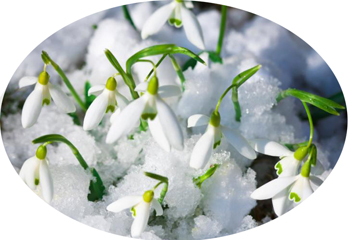

Posted February 4, 2022

Winter & Spring meet on Candlemas
Catholics understood that the victory of the daylight over the darkness at Candlemas was symbolic of Our Lord's victory over the Devil's reign. On Candlemas, the Church honors Our Lord through the words of holy Simeon as the "light to the revelation of the Gentiles."
Simeon's prophetic canticle of Our Lord's coming victory was reflected in nature's cycle. Just as the darkness of winter was losing its power over the world, so too was paganism and immorality approaching its demise with every day that the Christ Child grew older.
The sun's triumph reflected in people's customs
Austrian children attentively watched the sky on Candlemas Day to see if they could catch a glimpse of the sun breaking through the clouds of the dark winter sky to shed its rays upon the earth. When a ray was seen, the children sang a lovely song greeting the light:

'O you bright sun, come, peek out
from behind the hills!'
God sends you from His Heaven bright.
Your cheerful glow and golden rays
May bring us happy summer days.
Lead us through earthly toil and strife
To everlasting light and life. (1)
On Candlemas evening, the children in some Russian villages sat near the outskirts of the town listening to legends told by the elders of the town. At dusk, they expectantly waited to see if the sun would peep from behind the mountain before sunset, which would denote the quick arrival of Spring. They sang a traditional song that began, "O you bright sun, come, peek out from behind the hills!" (2)
In the Middle Ages, Candlemas was a "Quarter day" when servants and maids were paid for the year, accounts were settled, and tenants paid their rent. The landowners often invited their tenants along with their families to a grand banquet after the rent was paid. In Austria, the farm servants were given a feast prepared by the farmer's wife herself. (3)

Moving the cattle from the hay meadow & fields
Shoemakers and other artisans who worked indoors put away their candles on this day as the return of the light removed the need for candlelight until the darker days of Autumn. (4) Candlemas not only changed people's work customs, but also was the marker to determine the future weather. After Candlemas, a man could expect to either have another strong blast of Winter's frost and snow or sweet signs of the coming Spring.
In England, the people believed that the badger woke up from hibernation on this day and the weather determined whether he went back into his hole or remained above ground. If the badger saw his shadow due to sunny weather, he went back to sleep expecting a long winter.
The Germans used the same method to discover the upcoming weather, except that they replaced the badger with a hedgehog or, in some places, a bear.

Pennsylvanian man holding "Punxsutawney Phil"
The town of Punxsultawney, Pennsylvania even made an official town groundhog named "Punxsutawney Phil." For over 120 years, starting in 1887, people have been following the predictions of this groundhog. Even today, this groundhog is watched carefully as he leaves his den to see what his reaction will be and a festival is held in the town. (5)
Symbolic foods & flowers of Candlemas
Catholics of the past not only observed the animals during this time of the year, but also the plants, many of which have deep symbolic meanings.

Snowdrops give a hope for Spring as they peep through the snow
To honor this pious legend, people did not bring Snowdrops into their house before Candlemas. On that day, bunches of Snowdrops were collected and brought inside to purify the house. In Italy and other places in Europe, the image of Our Lady on the church altar was removed and replaced with Snowdrops which were strewn over it to symbolize the purity that Our Lady radiates wherever she goes. (7)
In addition to contemplating the symbolism in nature, Catholic peoples also prepared food that reflected the joy of the day.
In France, Belgium and Swiss Romany the people eat many special carnival treats on this day such as galettes, crêpes, beignets and cidre. Some people attribute the origin of this custom to Pope Gelasius I who provided for the pilgrims arriving in Rome by having pancakes prepared for them. (8)
Crêpes are also symbolic of the sun, making them a fitting dish to commemorate the return of sunny days at Candlemas. (9)

Making crepes in France on 'Chandeleur' or Day of the Crepes
The change in the natural world reflects well the transition that Candlemas marks in the liturgical year. In the liturgical calendar, Candlemas is the last day of the Christmas season. In the past, many Catholics cherished every moment of the Christmas season, keeping up the joy and merriment of Christmas until the 40 days had come to an end.

Children sing before the crèche is removed on Feb. 2
In most countries, even if other decorations were removed on the Epiphany, the crèche or Christ Child remained in a prominent place until Candlemas. In many French homes, the crèche was reverently put away on the afternoon or evening of Candlemas.
Christmas plants and greenery and the Yule log were also burned on Candlemas (if this was not already done on the Epiphany) as a last farewell to Christmas. The ashes were spread on fields and gardens to bring a successful harvest and protection against blight.
Some English farmers fed the Christmas greens to their cattle to protect them from disease. People saved sprigs of holly from the church or sprigs collected on Christmas Eve as efficacious means to protect themselves against demons and witches. (10)

Mexicans - poor and rich - bring the Niño Dios to the church to be blessed

In Mexico, the Christ Child (El Niño Dios) who has lain in the family crib since Christmas Eve is dressed in regal garments and carried to the church to be blessed after Mass. In doing this, the Mexicans unite with Our Lady in her journey to the Temple for the Presentation of Our Lord. On returning home, the Christ Child is seated on a chair or throne to represent the new focus from Our Lord's childhood to His adult life.
Families and friends then enjoy a fiesta featuring homemade tamales prepared by the host or hostess of the party. The person given this honor is the one who received the piece of the Rosca de Reyes (a circular sweet bread) in which the figurine of the Christ Child had been hidden on the feast of the Epiphany. (12)
In some places, the ceremony of saying farewell to the Christ Child was public. In the Italian city of Castelpoto, there was an ancient tradition of solemnly kissing the Child Jesus displayed at the high altar for one last time on Candlemas before he was ceremoniously removed to make way for the more somber adornments of Septuagesima.
All of these customs and symbols display a Catholic spirit that harmonically unites the natural season with the feasts of the Church. May we be given the grace to regain this spirit so that the meaning and symbolism of the Church's feasts may give us a new and more transcendent view of the world.

Snowdrops, known as Candlemas Bells or
the Purification Flower
- Francis X Weiser, The Holyday Book (London: Staples Press Limited), p. 93.
- https://nicholaskotar.com/2017/02/15/meeting-of-the-lord/
- http://www.brauchtumskalender.at/brauch-87-mariae_lichtmess
- Steve Roud, The English Year (Penguin Books: 2006), p. 40.
- https://www.fisheaters.com/customstimeafterepiphany3.html
- Vincenzina Krymow, Mary's Flowers: Gardens, Legends and Meditations (Cincinnati, Ohio: St. Anthony Messenger Press, 2002), p. 64.
- WM. Hackwood, Christ Lore: Being the Legends, Traditions, Myths, Symbols, Customs, and Superstitions of the Christian Church (London: Elliot Stock, 1902), p. 55.
- https://www.afrenchcollection.com/la-chandeleur-or-candlemas-a-french-tradition/
- https://frenchculturalcenter.org/events/chandeleur-2016/
- H. Pomeroy Brewster, Saints and Festivals of the Christian Church (New York: Frederick A. Stokes Company, 1904), p. 92.
- Rev. Bernard Stokes, O.F.M., How to Make Your House a Home (Washington D.C.: Family Life Bureau, 1955).
- https://www.theyucatantimes.com/2020/02/dia-de-la-candelaria-what-is-it-and-how-do-mexicans-celebrate-it/

Posted February 4, 2022
______________________
______________________
 |
 |
 |
 |
 |
 |


